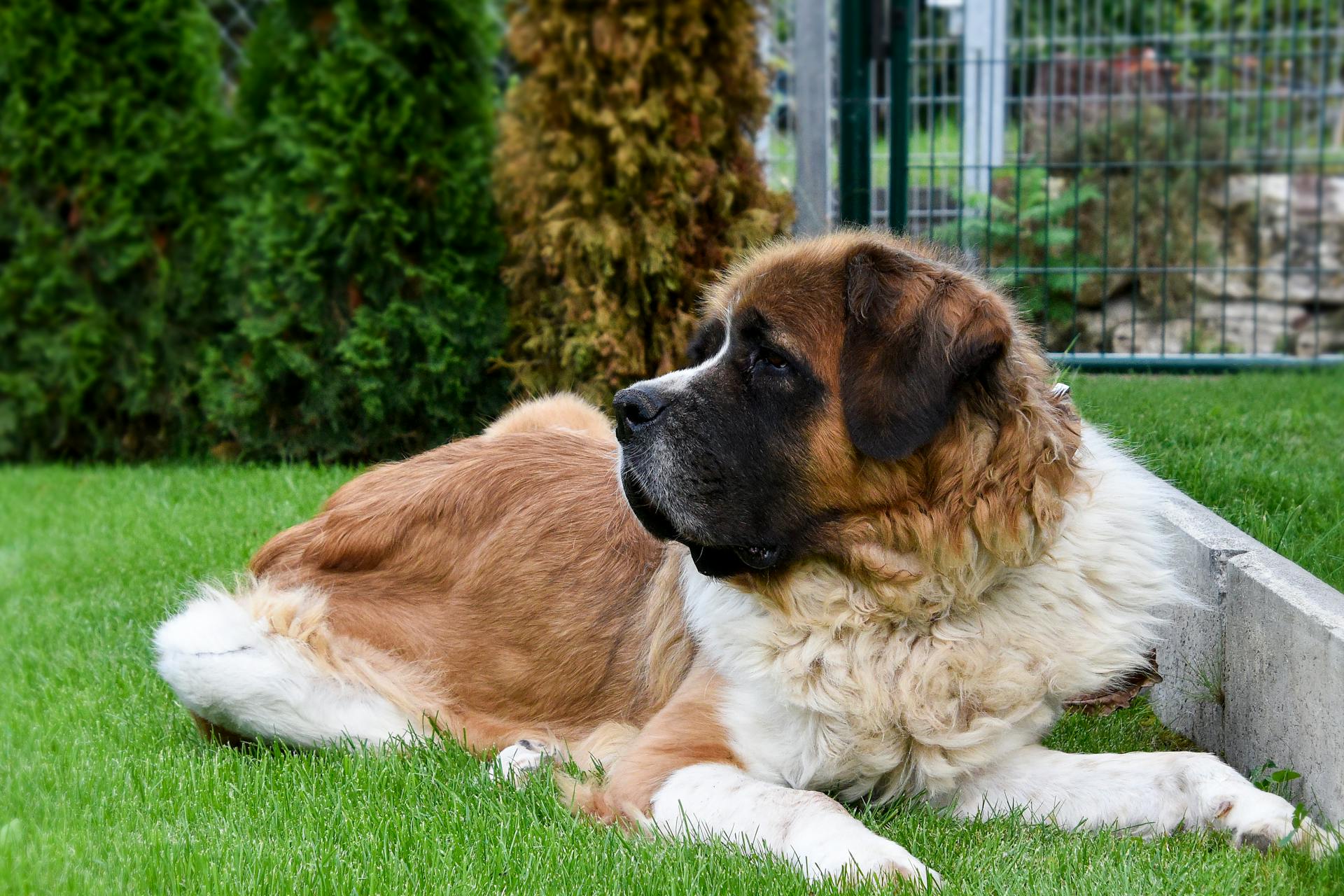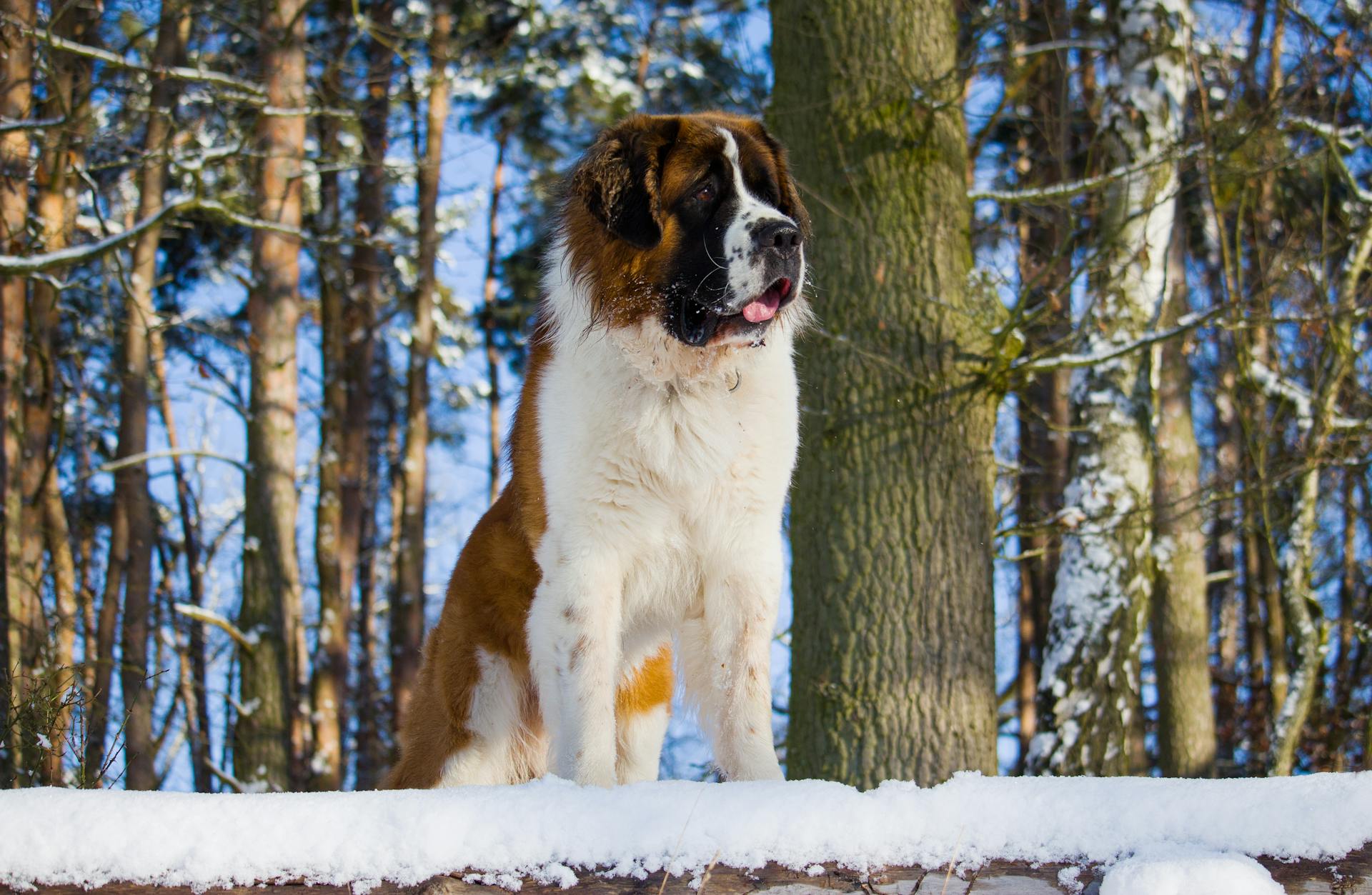
The St Bernard dog has a rich history that spans centuries, dating back to the 17th century in the Swiss Alps.
They were originally bred to help monks rescue travelers stranded in the mountains, where the harsh weather and terrain made it difficult for people to survive.
The monks at the Great St Bernard Hospice, a monastery located in the Alps, played a crucial role in developing the breed.
Their main goal was to create a dog that could withstand the extreme conditions and locate people in need of help.
Early History
The Saint Bernard's early history is a fascinating tale that spans centuries. Saint Bernard-type dogs were present in the region now known as Switzerland since ancient times.
The Germanic tribes who inhabited the area used their canine giants as war dogs, striking fear into the hearts of even the most battle-tested Roman legions. These fearsome, four-legged goliaths were a force to be reckoned with.
Expand your knowledge: St Bernard Dog Colors
The Romans had their own dog of war, the ferocious Asian Molosser, which breed historians believe was bred to the native giants of the Alpine valleys in the first two centuries AD. This marked the beginning of the Saint Bernard's 1,600-year march to the AKC Working Group.
For hundreds of years, these dogs went without a specific name, being referred to as hospice dogs due to their association with the monks.
The Origins
The St Bernard dog breed originated in the Great St Bernard Hospice in the Swiss Alps.
The hospice was a crucial stopover for travelers and traders crossing the treacherous mountain pass.
The breed was developed to assist with search and rescue missions, and to help find missing travelers.
They were trained to locate people buried under snow.
Their keen sense of smell and strength made them invaluable assets.
Their ancestors were likely the Roman Molossus and the Tibetan Mastiff.
Suggestion: St Bernard Boxer Mix Breed
Breed Development
The St. Bernard breed was developed in the Swiss Alps, where monks at the Great St. Bernard Hospice bred large dogs to help rescue travelers stranded in the mountains.
Their primary goal was to create a dog with exceptional strength, endurance, and a keen sense of smell to locate and rescue people in need.
The monks crossed local Alpine dogs with larger breeds, such as the Mastiff, to achieve the desired characteristics.
This deliberate breeding process led to the development of the St. Bernard's distinctive physical features, including its massive size and thick coat.
The monks' efforts paid off, and the St. Bernard became an invaluable asset in the Alps, helping to save countless lives over the centuries.
The Dog
The St. Bernard is a large and powerful dog breed that originated in the Swiss Alps.
Their distinctive tri-colored coat is a result of their original purpose as a herding dog, with the white coat serving as a camouflage in the snow.
These dogs were bred to be intelligent and calm, making them perfect for working in harsh weather conditions.
Their keen sense of smell and athleticism allowed them to navigate the treacherous mountain terrain with ease.
Their iconic shaggy coat is not just for show, it also serves as a natural insulation against the cold.
Their calm demeanor made them an ideal choice for rescue work, where they could remain composed in emergency situations.
Temperament and Intelligence
The Saint Bernard's temperament is truly one of its best qualities. They are loyal and affectionate pets with their families.
One thing to keep in mind is that Saint Bernards can be less open to strangers, which is understandable given their role as watchdogs. They are adaptable animals and tolerate cold weather well.
Saint Bernards are intelligent animals, and it's no surprise given their history of work. However, they also have an independent streak.
Early training and socialization are crucial for Saint Bernards, especially considering their large size. They are sensitive dogs that don't enjoy being alone.
Active households with someone always around are a great fit for Saint Bernards, as they thrive on companionship.
Discover more: Pictures of Saint Bernard Dogs
Lost History
A gap exists in the Saint Bernard's history, leaving a 700-year void in written records. This is a surprising fact that highlights the breed's mysterious past.
The Saint Bernard Club of America notes that no written records existed for this long period of time. This lack of documentation is unusual, especially considering the breed's rich history.
A surprising discovery helped fill in this gap - artwork depicting the Saint Bernard dog. This artwork provided a visual representation of the breed, giving us a glimpse into its past.
Bernard's History
The St. Bernard breed originated in the Great St. Bernard Hospice in the Swiss Alps, where monks would use the dogs to help rescue travelers stranded in the mountains.
These early St. Bernards were bred to be strong, intelligent, and gentle, with a keen sense of smell that allowed them to track down missing people.
The monks would often give the dogs a small amount of brandy to help keep them warm and energized during their rescue missions, which is how the breed got its reputation for being a bit of a drinker.
Bernard
The Saint Bernard has a rich history, and one fascinating fact is that they went without a name for hundreds of years. People simply called them hospice dogs because of their association with the monks.
Their origins are tied to the Saint Bernard Hospice, where the monks preferred the shorthaired variety. This is likely due to their practical needs, as the shorthaired Saint is easier to care for.
The Saint Bernard's size is quite impressive, reaching a height of 30 inches and weighing up to 180 pounds. They come in both shorthaired and longhaired varieties.
Despite their massive size, Saint Bernards are quiet indoor dogs who make wonderful family friends. They're calm indoors, but it's nice to have a yard where they can stretch out.
Living with a Saint Bernard requires some tolerance for mess, as they drool and shed, and track in mud and dirt.
Bernard's Iconic Barrel
The Saint Bernard's iconic barrel has a fascinating history. It all started with a painting by Sir Edwin Landseer in 1820.
The image of a hospice dog with a spirit-filled barrel originated from Landseer's artwork "Alpine Mastiffs Reanimating a Distressed Traveller." This painting is where it all began.
The likeness of the Saint Bernard with a barrel stuck, making it synonymous with the breed. It's a classic image that people have of these pups.
Frequently Asked Questions
What is an interesting fact about Saint Bernards?
St. Bernards have a rich history, with the breed being known by various names before being officially recognized in the mid-1800s. One famous St. Bernard, named Barry, is renowned for his heroic rescue efforts and has become an iconic figure in the breed's history.
What two breeds make a Saint Bernard?
The Saint Bernard breed is a result of refining various large molosser-type breeds, including the Newfoundland and the Great Pyrenees. These two breeds are among the key ancestors of the modern Saint Bernard.
What kind of dog was Cujo?
Cujo was a Saint Bernard. He was a friendly breed before contracting rabies.
Are Saint Bernards German?
No, Saint Bernards are not German, they originated in the Swiss Alps and north Italy and Switzerland. They were bred for rescue work in these mountainous regions.
Featured Images: pexels.com


